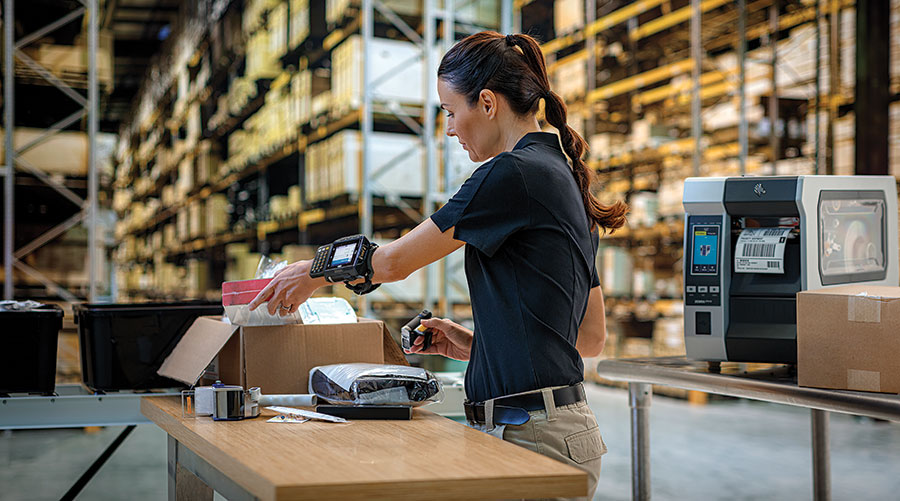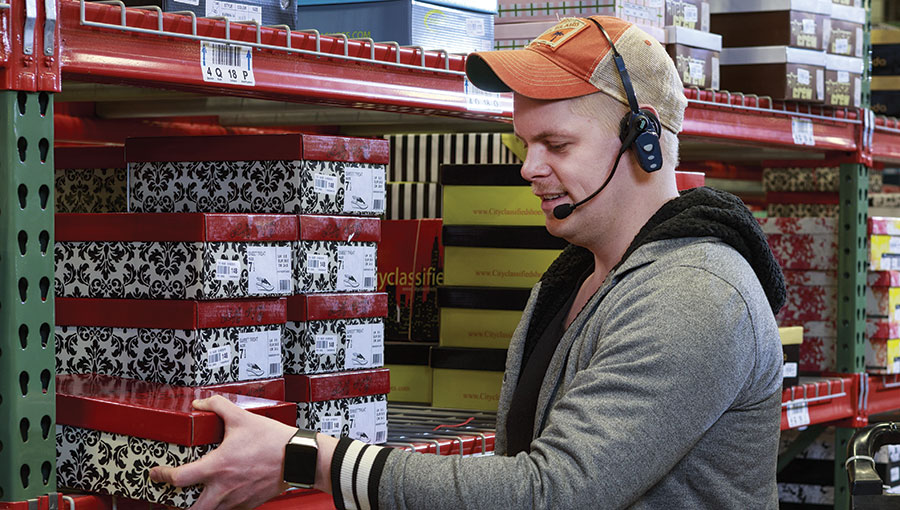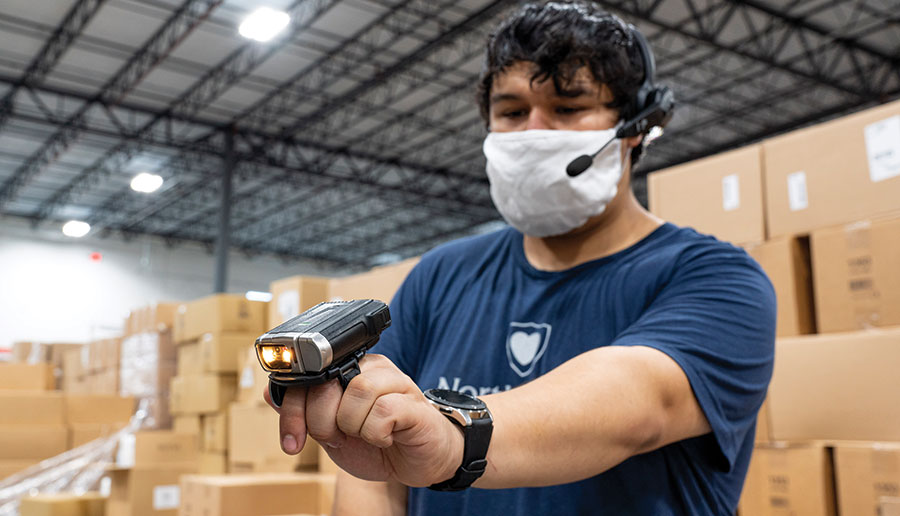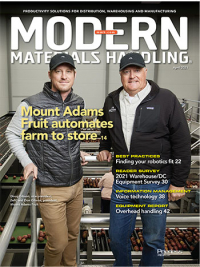Voice Technology: From revolution to evolution
Distribution centers no longer want voice for voice itself. Today it serves as one piece of an integrated solution for optimized operations.
When voice technology first hit the market in the 1990s, it promised a warehousing revolution. Using rugged, dedicated devices that ran speech recognition software, employees could put down their scanners and pick hands-free while performing voice-directed picking tasks.
That revolution didn’t happen overnight. The first iterations of voice technology were cumbersome, costly and wonky. But they set the stage for greatly improved efficiencies within the DC today.
In fact, yesterday’s DC workers might not recognize today’s voice devices, which have evolved to sophisticated, streamlined Bluetooth scanners, headsets and even smart watches. But the changes don’t end there. Rather than stand-alone tech, modern voice technology is part and parcel of optimized solutions.
Take, for example, a U.K.-based third-party logistics provider (3PL) operating a multi-channel DC full of portable electronics and accessories. The DC was using an RF-based picking process using ring scanners. While accurate, the screen- and scan-based process added time to each pick. What’s more, the warehouse management system-directed pick-to-cart process was travel intensive.
Eliminating scanning entirely was not an option because many of its products had unique IDs that required manual data capture in the picking process. However, working with solution provider Lucas, the company implemented warehouse optimization software that uses a batching algorithm to create optimal work assignments for e-commerce and retail orders.
The new solution still involves bar code scanning, but also uses voice to direct associates to a pick location and then tells them the number of units to pick and/or scan in a bar code. The mobile application combines RF and voice on smart watches that deliver visual prompts complementing the voice-directed prompts.
The multi-modal voice and scanning solution assisted the DC in what became a pandemic surge of e-commerce orders, and the 3PL has reported picking gains well in excess of its original target of 34%.

Traditional voice-directed picking can be combined with a wearable display that allows the picker to confirm a pick.
As with other similar scenarios, the Lucas example is clearly not your father’s voice technology. “People don’t get very excited about voice on its own,” says Lucas’ Justin Ritter, vice president of operations and customer success. “They want a full solution that complements what they already have in place.”
If that means the customer has a warehouse management system (WMS), then, voice solution providers can now fill in the gaps that the system doesn’t have in conjunction with the voice application, serving as a component of an overall optimization package. “Today’s voice solutions are integrated into real-time distribution software platforms that manage all pick, pack and ship,” says Jen Maloney, Numina Group’s marketing director.
An evolution
Not only has the technology and integration of voice changed, but so have its applications. In the DC, voice held a dedicated place for picking when it first appeared on the market. Now, however, its applicability is more far reaching. It’s also more often than not part of a multi-modal approach to operations.
This is what Zebra Technologies is seeing, says Mark Wheeler, director of supply chain solutions. Zebra’s Workforce Connect platform facilitates the flow of information between a variety of devices in a host of applications.
“The platform connects with any device, on any vehicle, handheld or wearable,” Wheeler says. “Whatever the job that employees are working on, they can communicate the results to manage it.”
This might include traditional voice-directed picking combined with a wearable display that allows the picker to confirm a pick. Or voice could send the picker on the fastest route, and he or she might scan the pick with a handheld device to verify accuracy before dropping the SKU into a carton, eliminating a quality control check or repacking.
NorthShore Care Supply, one of Numina Group’s customers, is a good example of the full-system, multi-modal approach with voice. The company created a system-directed solution, where pickers receive instruction with voice in high density zones and then pick to autonomous mobile robots (AMR). Combined, technologies like these can take picking productivity up to 250-plus lines per operator per hour, according to Numina.
The case for multi-modal combinations with voice goes beyond the numbers, however.
Keith Phillips, president and CEO of Voxware says the multi-modal approach also serves a wide demographic well, offering a “something for everyone” assortment of devices. “You can pair the technology to the individual,” he says. “You might have a 21-year-old who is very comfortable working off a smart phone, where a 60-year-old employee might struggle with it.”
This drill down also extends to the task, where Phillips says Voxware helps DCs match up the task to the tech. “When we work with a client, we do an in-depth review of their DC processes, the products they handle, the workforce demographics and more,” he explains. “A lot comes into play, and we develop a total solution from these inputs.”
Underlying it all, are systems like Workforce Connect or Numina Group’s Real-Time Distribution Software, an execution and control system. These software systems are a big part of what sets modern voice technology apart from their predecessors, which existed more as stand-alone technology.

A multi-modal voice and scanning solution assisted the DC in what became a pandemic surge of e-commerce orders.
Verticals and the pandemic
As is the case in many industries, the pandemic has served to accelerate the evolution of voice technology, as well as the verticals where it has a strong presence. “If you look at where we are now, the two hottest verticals are grocery and retail,” says Phillips. “Depending on the products, some DCs can’t keep them on the shelves. Buying habits have shifted, and this has only made accuracy that much more important.”
Numina’s Maloney notes that people are buying more food online than ever due to the pandemic, and that “voice is the no-brainer here because it can work in any temperature and get employees through the process quickly.”
Over the years, the industry has learned that voice has a sweet spot, says Wheeler. “This has a lot to do with the cadence of the operation,” he explains. “Too slow and voice doesn’t bring enough value. Too fast, and you need wearables or other visuals. This is why grocery has always been a good fit.”
The food and beverage sector has also been a strong vertical for voice. As with other segments, this vertical is using voice as part of an overall enterprise solution. One adopter that has combined voice with picking and analytics for greatly improved performance is New Jersey-based Anacapri Foods. The company operates out of a 130,000-square-foot DC and sought out a solution that it could easily integrate into its existing infrastructure.
Working with Voxware, the company rolled out the solution during a slow month to ensure that employees could spend extra time learning to trust it. With compensation tied to pieces picked per hour, many pickers were skeptical. In the end, however, the team increased volume by 20%.
In addition to improved productivity rates and real-time analytics, Anacapri has been using voice to train new employees. Phillips says this is an area where voice excels and is particularly applicable in the pandemic. “We can hand a new employee a device and a headset or smart glasses, and they can log on, get user instruction from a screen and be productive in 10 minutes,” he says.
This functionality also carries over to the pre-shift meetings that were common before the pandemic. “Many DCs used to get the team together to plan the day at the beginning of a shift and now they don’t want to do that,” says Wheeler. “If materials handlers have a mobile device, management can communicate with them that way, eliminating the need for in-person instruction and training.”

Today’s voice solutions are integrated into real-time distribution software platforms that manage all pick, pack and ship
In some cases, however, the pandemic has brought the need for voice into non-traditional DC environments. “We’re starting to see different channels enter e-commerce now, and they don’t have the infrastructure for it,” says Ritter. “We’re seeing customers with new order profiles and new needs for picking. Voice is an appropriate part of their new e-commerce strategies and we’re helping them retrofit their operations for increased efficiencies.”
As providers look ahead, they see an ever-more sophisticated future when it comes to voice. “Voice is commoditized,” says Ritter. “Our core business today is orchestration, and in the future, that will likely include less reliance on humans as securing labor becomes more difficult.”
Phillips agrees. “Companies will continue to see high turnover in the DC,” he says. “We’re focused on helping customers manage a workplace and its labor pool more effectively than in the past. We think those challenges will only increase in the future, so technology and optimization will only become more critical.”
As pandemic-driven acceleration of e-commerce makes it a bigger part of every company’s landscape, expect voice—as part of an overall optimization package—to show up more and more going forward.

Article Topics
Mobile & Wireless News & Resources
ProGlove and topsystem partner on hands-free picking solution CaPow’s power-in-motion solution eliminates charging downtime International Retailer Optimizes Efficiency Through Asset Lockers Writing the book on streamlined data capture 60 Seconds with Diego Vega from the Hanken School of Economics The Rebound: 3D Transformation at GE Appliances Barcoding, Inc. joins Graham Partners More Mobile & WirelessLatest in Materials Handling
Registration open for Pack Expo International 2024 Walmart chooses Swisslog AS/RS and software for third milk processing facility NetLogistik partners with Vuzix subsidiary Moviynt to offer mobility solutions for warehouses Materials Handling Robotics: The new world of heterogeneous robotic integration BSLBATT is looking for new distributors and resellers worldwide Lucas Watson appointed CSO for Körber’s Parcel Logistics business in North America Hyster recognizes Dealers of Distinction for 2023 More Materials HandlingAbout the Author
Subscribe to Materials Handling Magazine

Find out what the world's most innovative companies are doing to improve productivity in their plants and distribution centers.
Start your FREE subscription today.
April 2024 Modern Materials Handling

Latest Resources












